Review: The Ultra-Limited Eagle Rare 25 Is A $10,000 Bourbon - And It Might Be Underpriced
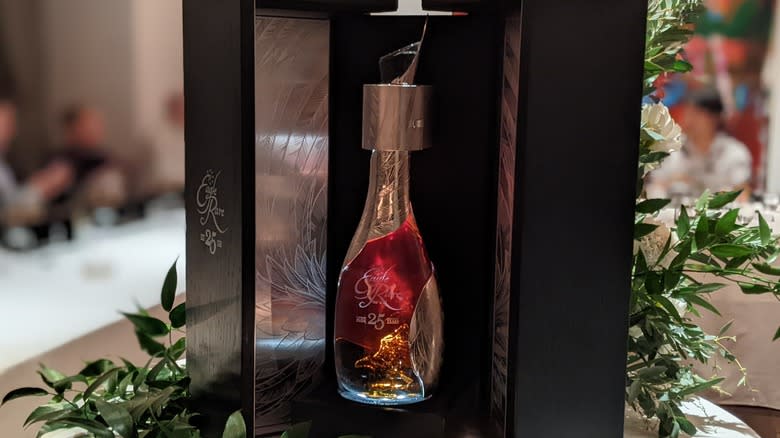
Folks, it is hard to make an elderly bourbon. We're avowed believers in the 12-year sweet spot for a lot of bourbons made under Kentucky conditions. However, in a recent visit to the Buffalo Trace distillery, the professionals there told Tasting Table that they think the optimum spot for most of the distillery's products is a little younger, in the 8 to 10-year range. Only certain barrels and conditions can carry on without absorbing off-putting tannins from the barrel — or desirable tannins at an undesirable amount — while continuing to enrich.
Precisely which barrels and why are mysteries that Buffalo Trace has been experimentally trying to solve through careful monitoring in pursuit of the perfect barrel. Enter the Eagle Rare 25-year expression. On our recent tour of the facility, standing in the cradle of this new concoction, we took note when the Distillery VIP Visitor Lead Freddie Johnson told us that consistency can be a much smaller target to hit than greatness. It makes sense then that an unprecedented code-cracker like Eagle Rare 25 would sell for quite a bit — but gird yourself for sticker shock. The oldest Eagle Rare to ever come out of Frankfort, KY, will set you back $10,000.
Read more: The 40 Absolute Best Cocktails That Feature Only 2 Ingredients
What Is Eagle Rare 25-Year Bourbon?
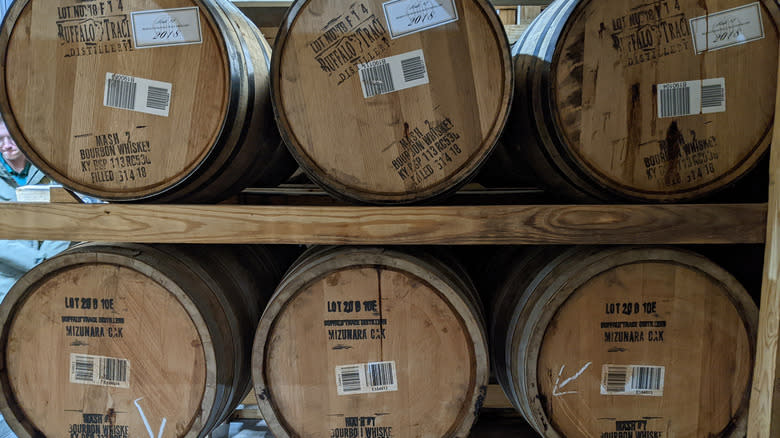
Released on the silver anniversary of its casking, Eagle Rare 25 soars to the greatest heights in the Buffalo Trace line, thanks to aging in a very different space. In the concrete and chilled Warehouse P, the whiskeys that form this vintage Eagle Rare are subject to much more temperature and humidity control, along with a couple dozen other factors, according to the distiller. It is a special bourbon.
Though some regular expressions do come close to spending this much time in the barrel — Buffalo Trace puts out the highly sought Pappy Van Winkle 23-Year and once released a 25-year edition of Old Rip Van Winkle — 24 years seems to be the cap on maturation, barring outliers. Thus, Buffalo Trace's accomplishment in the new Eagle Rare release promises a consistently desirable (and new) tideline. And it proves to have the means to keep producing.
Occasionally special releases shatter bourbon's age threshold. A recent example is Final Reserve James Thompson & Brother's straight bourbon, released after a mighty 45 years of aging. (That particular bottle came with some high disclaimer about how to smooth out its bite.) Yet, the selling point of Eagle Rare 25 isn't that it's something you get through; this is an elite bourbon ready to wow you right out of the bottle. In essence, you don't have to approach Eagle Rare 25 like a "you only live once" experience that tests your capabilities.
How Much Does Eagle Rare 25 Cost?

Eagle Rare 25-year goes for a whopping $10,000. Given that Eagle Rare 17-year typically launches from the suggested retail price of several thousand dollars before it even makes it to liquor store shelves, and the Double Eagle Very Rare goes for even more, the price tag of Eagle Rare 25-year isn't surprising. But it is daunting. Whiskey enthusiasts have come to expect the high cost of an ultra edition bourbon that, even as a widely distributed annual release, is greater than your average spend.
Then again, you might just get lucky enough that it's so highly priced that the cost stays put as its own barrier to entry. If very few people are willing to pay $10,000 for a 750-milliliter bottle of bourbon, there might not be the demand present for sellers to charge more. Still, anybody who can afford it at MSRP probably won't sweat double the cost.
Where Can You Find Eagle Rare 25?
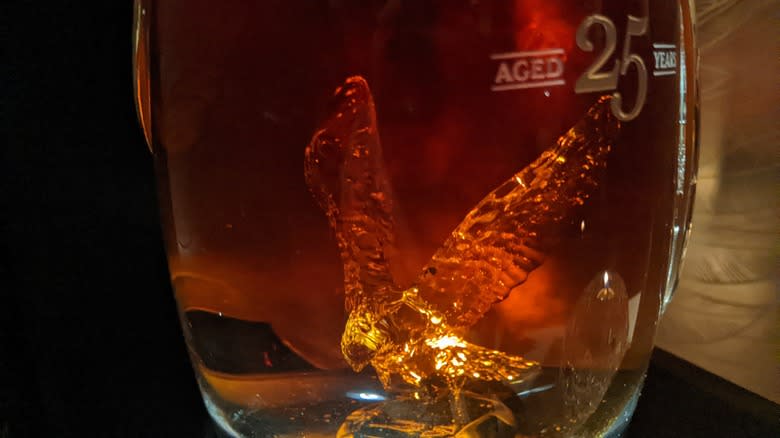
Eagle Rare 10-year is hard enough to find by itself, and that's just the regular edition. The 17-year is the annual edition in the Buffalo Trace Antique Collection, while Double Eagle Very Rare is a 20-year you'll seldom see. All of this is to give you some idea of just how hard you're going to have to look to find the 25-year anywhere; only 200 bottles exist globally.
Buffalo Trace isn't disclosing who gets them but says it's going out to venues and liquor stores in "very limited quantities," so you can probably narrow it down to a few specialty shops and big-deal bars in cities like Vegas, New York, and Los Angeles ... anywhere someone with deep pockets wants to celebrate. But even if you've got money to burn, that's just the suggested retail price, and you might see this for double that at its debut. Locating an unopened bottle is going to be as difficult as it is to raise the funds to purchase it.
At 200 bottles, you do have the boomerang advantage that Eagle Rare 25-year is so noteworthy it will become its own renowned selling point. At any rate, to find this bottle, start with the likeliest candidates: restaurants that serve billionaires or those with devoted libraries of booze, like Seattle's Canon. There's a small list of bars likely to serve whiskey this fine.
Eagle Rare 25 Tasting Notes

Swirling the Eagle Rare 25, its golden brown substance leaves spacious legs behind. Eagle Rare 25 clocks in at 101 proof, a number we will continue to insist is the sweet spot for bourbon for reasons we cannot explain, only observe.
There's only a moderate burn on the nose: low but lingering; you can sense its age at the first sniff. Eagle Rare 25 introduces itself with a detectable depth of character. "Hi," it says, "my name is oak."
Moving past that handshake, it's marvelous on the tongue: strongly nutty but never overbearing. This is the accomplishment of achieving this age statement; you're engaging with the wood but never being battered by it. It's impossible to sip this and not think of a Scotch. The cooler conditions, along with humidity control, have tempered the tannins. But then it does remind you that it's a bourbon with that kick of sweet yet explosive corn. This tastes a bit like mounting an old bronco that could buck if it wanted to but has no cause to do so.
If you're looking for comparison-flavor notes, we're inclined to agree with Buffalo Trace's own report of vanilla and dark fruit. We didn't get butterscotch or interpret the nut taste to be so chocolatey that it runs a through line from nose to finish. Chewing brings a bit more of that out, but we found it's mainly detailed oak in a rare delivery system embellished with field herbs.
How Does It Compare To Other Eagle Rare Bourbons?
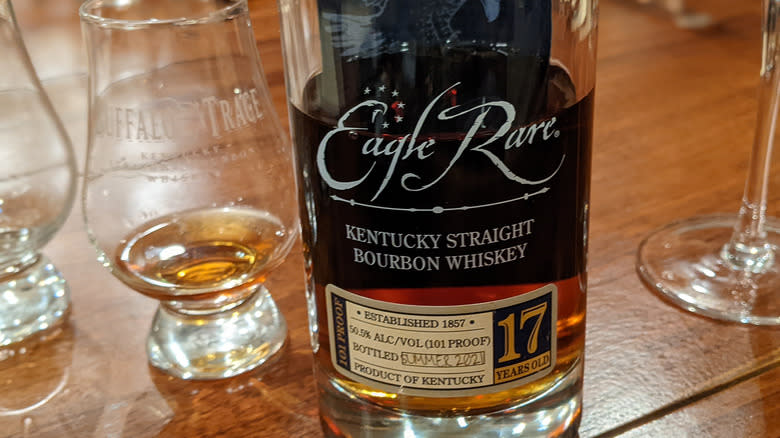
Eagle Rare is already one of the more sought-after releases from Buffalo Trace, distributed through allocation rather than open orders and only released once a year. The Eagle Rare 10-year uses Buffalo Trace's mash bill #1, which has undisclosed proportions but a low-rye bill of likely 10% or less. Mash bill #1 is considered to be the flagship flavor of the distillery, as it's used in the eponymous bottles of Buffalo Trace, Stagg, the underrated bourbon Benchmark, and the premium sour-mash Colonel E.H. Taylor. (Tasting Table considers the latter as one of the best bourbon brands out there.) Eagle Rare 10 is tough to find but a good value when you do, considering its price is usually inflated but seldom inordinate.
While you might also be lucky enough to find Double Eagle Very Rare or the Antique Collection 17-year, odds are you're going to encounter the regular edition in a lot more places. If so, get a bottle and taste this award-winning juice for yourself. Its customary autumn release is well-timed, as this whiskey boasts all the rich flavors of the holidays: stone fruit and chocolates couched in the right amount of oakiness.
As with our tasting of the 2023 and 2022 Buffalo Trace Antique Collection, we found that Eagle Rare gets more surprising the older it is, bowing towards floral and herbal. It becomes nuanced and delicate rather than getting richer. So it is with the 25-year, which really presents like a Scotch.
Is Eagle Rare 25 Worth $10,000?
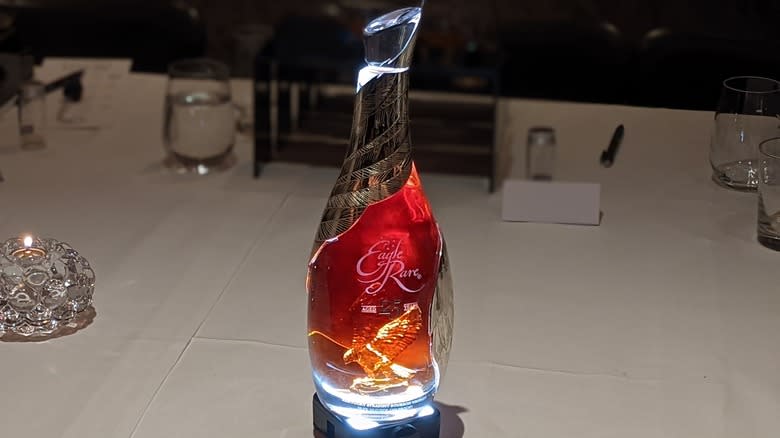
Buffalo Trace is correct that it's made an exceptional bourbon, and this wall-smashing age statement is certainly an achievement. If you're a tater, aider, or abettor, you might consider this a solid investment piece: a real milestone in the Before and After periods of bourbon production. This is a feat, and you're paying a premium for first past the post.
The Old Rip Van Winkle 25-year debuted at $1,800 but was reselling for $65,000 as of earlier this year, making it the most expensive bourbon of all time. It's reasonable to expect some similar performance from this breakthrough bourbon, even if Eagle Rare is a bit more for those in the know rather than the knee-jerk reacting Van Winkle casuals who've simply heard enough times that it's the best bourbon around.
Overall, it's easy to see how $10,000 today might become a quarter million or more in five years. More realistically, this isn't likely to see the same percentage leap as Old Rip Van Winkle. Even at 10 times growth rather than 36, if you're angling to own the first bottle of bourbon to top six figures, this a strong contender.For those buying Eagle Rare 25 to drink, well ... prepare yourself to enjoy it quite a bit without asking whether you really just had a $700 sipping experience. Leave it corked to pay for college, or try a small amount at a luxe bar.
Read the original article on Tasting Table.
